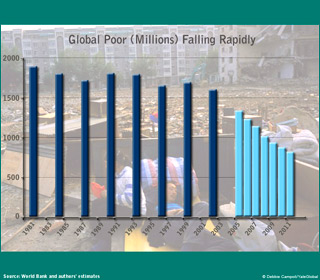A major success in a poverty-reduction goal for the new millennium – halving the proportion of people whose income is less than $1.25 per day – largely went unnoticed. The World Bank estimates poverty levels, but the most recent data is from 2005. By combining the recent country survey data of household consumption with latest figures on private consumption growth, Brookings Institution researchers Laurence Chandy and Geoffrey Gertz generated poverty estimates to the present day. They conclude that the world – even stubborn Sub-Saharan Africa – is in the midst of rapid poverty reduction; they credit economic growth and widespread development brought by globalization. Poverty reduction was one part of a key UN Millennium Goal, and global observers may sit up and take notice after two other key parts are achieved: full and productive employment for all and halving the proportion of people who suffer from hunger. In the meantime, the authors promise far-reaching consequences from rapid poverty reduction via growth. –
 Road to growth: Millions of Chinese have been lifted out of poverty, thanks to trade
Road to growth: Millions of Chinese have been lifted out of poverty, thanks to trade It is customary to bemoan the intractability of global poverty and the lack of progress against the Millennium Development Goals. But the stunning fact is that, gone unnoticed, the goal to halve global poverty was probably reached three years ago.
We are in the midst of the fastest period of poverty reduction the world has ever seen. The global poverty rate, which stood at 25 percent in 2005, is ticking downwards at one to two percentage points a year, lifting around 70 million people – the population of Turkey or Thailand – out of destitution annually. Advances in human progress on such a scale are unprecedented, yet remain almost universally unacknowledged.
Official estimates of global poverty are compiled by the World Bank and stretch back 30 years. For most of that period, the trend has been one of slow, gradual reduction. By 2005, the year of the most recent official global poverty estimate, the number of people living under the international poverty line of $1.25 a day stood at 1.37 billion – an improvement of half a billion compared to the early 1980s, but a long way from the dream of a world free of poverty.
Today, it’s estimated that there are approximately 820 million people living on less than $1.25 a day.
Behind these aggregate figures lies a somber reality. In assessing the fortunes of the developing world during the late 20th century, countries can be roughly divided into two categories: China and the rest.China’s stunning economic reversal – 30 years ago, only 16 percent of its population lived above the poverty line, but by 2005, only 16 percent stood below it – masks others’ failings. Excluding China, the 500 million decrease in global poverty becomes an increase of 100 million. In the world’s poorest region, sub-Saharan Africa, the poverty rate remained above 50 percent throughout the period, which, given the region’s rapid population growth, translated into a near doubling in the number of its poor. Similarly in South Asia, Latin America and Europe–Central Asia there were more poor people in 2005 than there were a quarter of a century earlier.
 The number of the world's poor is falling rapidly.
The number of the world's poor is falling rapidly. This depressing track record shapes perspectives on poverty that abound today. Global poverty has come to be seen as a constant, with the poor cut off from the prosperity enjoyed elsewhere. Only a radical change to the current global order – an alternative system to globalization or a massive exercise in redistribution – could possibly alter this destiny.
In a new study of global poverty, we upend this narrative. By combining the most recent country survey data of household consumption with the latest figures on private consumption growth, we generated global poverty estimates from 2005 up to the present day. Poverty reduction accelerated in the early 2000s at a rate that has been sustained throughout the decade, even during the dark recesses of the financial crisis. Today, we estimate that there are approximately 820 million people living on less than $1.25 a day. This means that the prime target of the Millennium Development Goals – to halve the rate of global poverty by 2015 from its 1990 level – was probably achieved around three years ago. Whereas it took 25 years to reduce poverty by half a billion people up to 2005, the same feat was likely achieved in the six years between then and now. Never before have so many people been lifted out of poverty over such a brief period of time.
 The MDG poverty target may already have been achieved.
The MDG poverty target may already have been achieved. Not only is poverty falling rapidly, it’s falling across all regions and most countries. Unsurprisingly, the greatest reduction has occurred in Asia. But it’s not just the dynamic economies of East Asia, such as China, recording great feats in poverty reduction; South Asian giants including India and Bangladesh, and Central Asian economies such as Uzbekistan also make great strides. Even Sub-Saharan Africa is sharing in this progress. The region finally broke through the symbolic threshold of a 50 percent poverty rate in 2008 and its number of poor people has begun falling for the first time on record.
This stunning progress is driven by rapid economic growth across the developing world. During the 1980s and 1990s, per capita growth in developing countries averaged just 1 to 2 percent a year, not nearly fast enough to make a serious dent in poverty levels. Since around 2003, however, growth in the developing world has taken off, averaging 5 percent per capita a year.
How and why sustained high economic growth in developing countries took hold are questions likely to be debated by economic historians for many decades. Already one can point to a number of probable sources emerging or accelerating around the turn of the century: an investment boom triggered by rising commodity prices; high growth spillovers originating from large open emerging economies that utilize cross-border supply chains; diversification into novel export markets from cut flowers to call centers; spread of new technologies, in particular rapid adoption of cell phones; increased public and private investment in infrastructure; the cessation of a number of conflicts and improved political stability; and the abandonment of inferior growth strategies such as import substitution for a focus on macroeconomic health and improved competitiveness.
The poor countries that display the greatest success today are those that engage with the global economy.
These factors are manifestations of a set of broader trends – the rise of globalization, the spread of capitalism and the improving quality of economic governance – which together have enabled the developing world to begin converging on advanced economy incomes after centuries of divergence. The poor countries that display the greatest success today are those that are engaging with the global economy, allowing market prices to balance supply and demand and to allocate scarce resources, and pursuing sensible and strategic economic policies to spur investment, trade and job creation. It’s this potent combination that sets the current period apart from a history of insipid growth and intractable poverty.
The fight against poverty has long been a moral and strategic goal of Western governments. But the record of the last few years is likely a surprise to them. In their eyes, the fate of the world’s poor largely depended on forging progress on three fronts: debt relief, more aid and freer trade. World leaders convened at numerous meetings to build support and momentum around these priorities, but despite these efforts successes were hard to come by: While more than $80 billion of poor countries’ debt has been forgiven, most countries failed to meet global aid targets, and the Doha Development Round has languished at the World Trade Organization.
Thankfully for the world’s poor, this logic turned out to be flawed. While progress on each of the three fronts would have been helpful for developing countries and their ability to tackle poverty, the significance of each was undoubtedly overhyped and said more about the West’s sense of responsibility and magnanimity than what was actually needed to deliver development.
Taking a long view of history, the dramatic fall in poverty witnessed over the preceding six years represents a precursor to a new era. We’re on the cusp of an age of mass development, which will see the world transformed from being mostly poor to mostly middle class. The implications of such a change will be far-reaching, touching everything from global business opportunities to environmental and resource pressures to our institutions of global governance. Yet fundamentally it’s a story about billions of people around the world finally having the chance to build better lives for themselves and their children. We should consider ourselves fortunate to be alive at such a remarkable moment.
Laurence Chandy is a fellow at the Global Economy and Development Program in the Brookings Institution. Geoffrey Gertz is a research analyst in the same program. Their paper, “Poverty in Numbers: The Changing State of Global Poverty from 2005 to 2015” is available here.
http://yaleglobal.yale.edu/content/little-notice-globalization-reduced-poverty











No comments:
Post a Comment